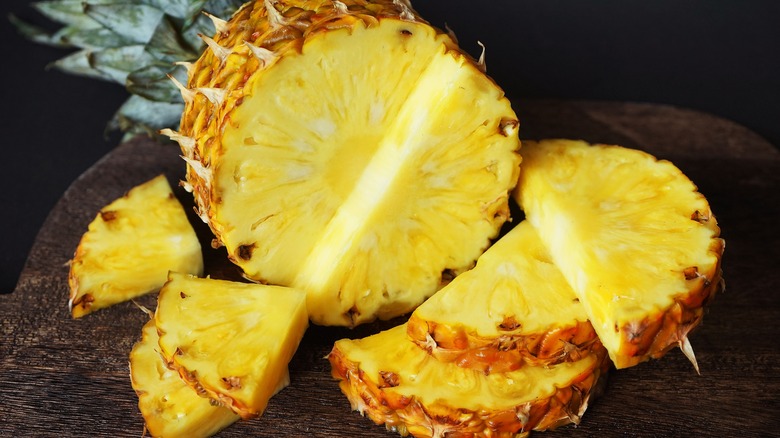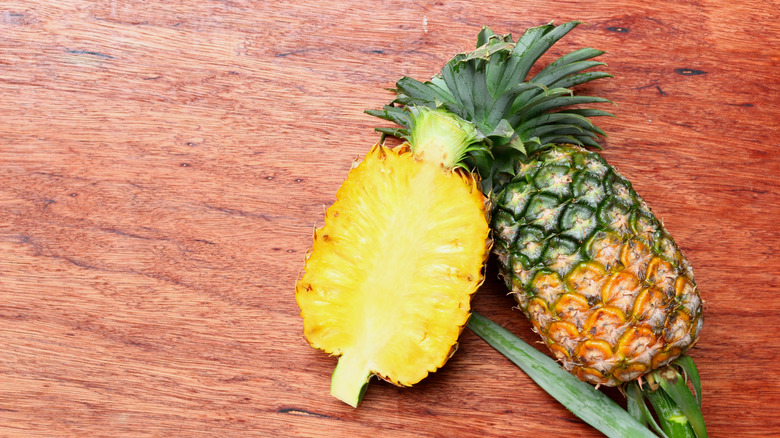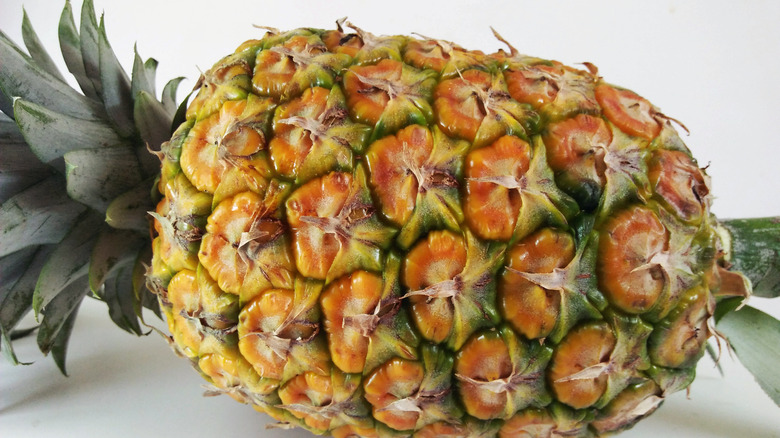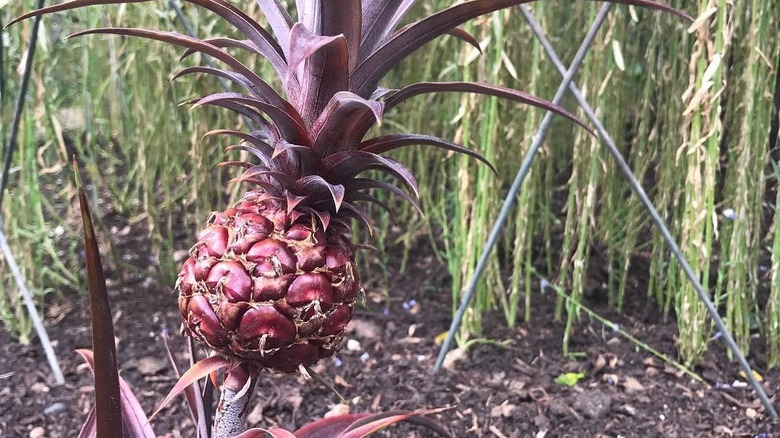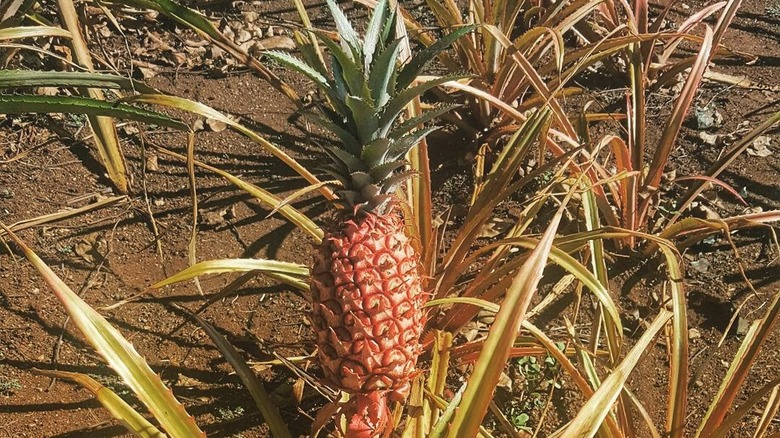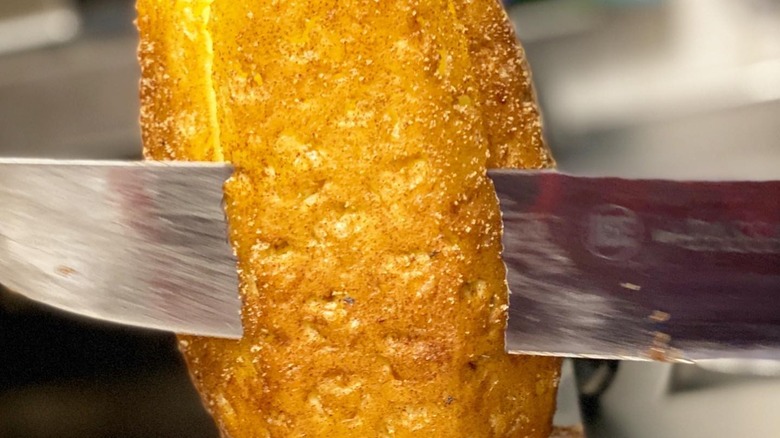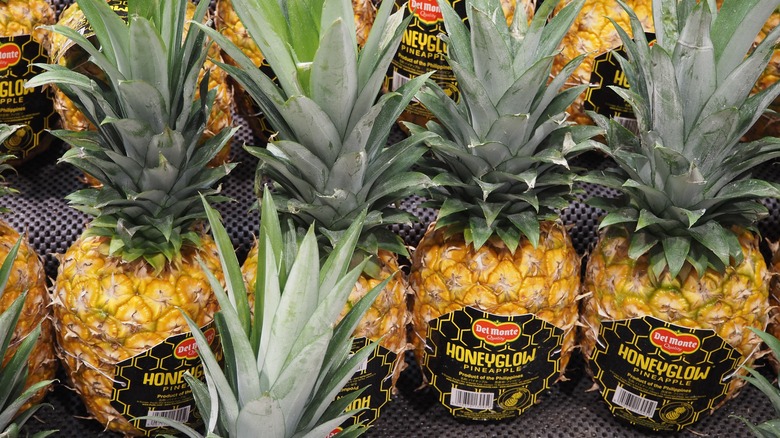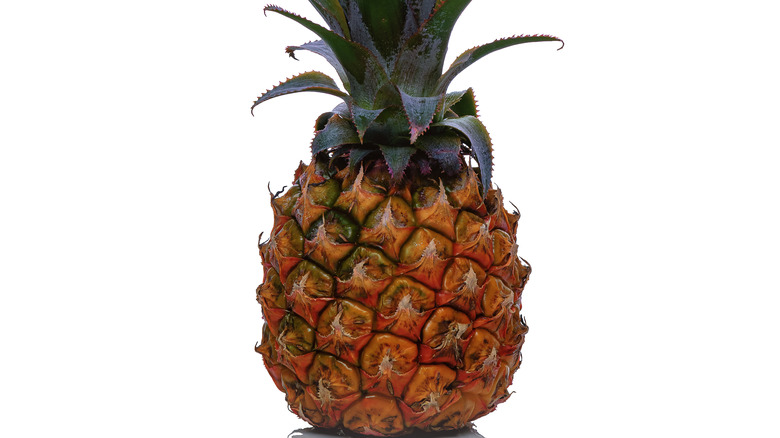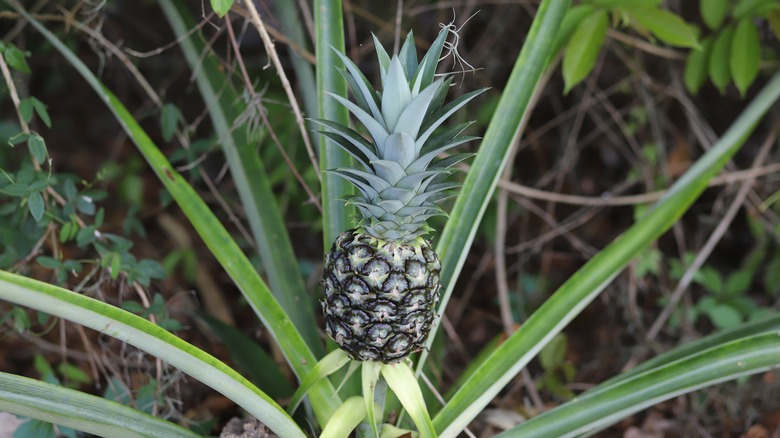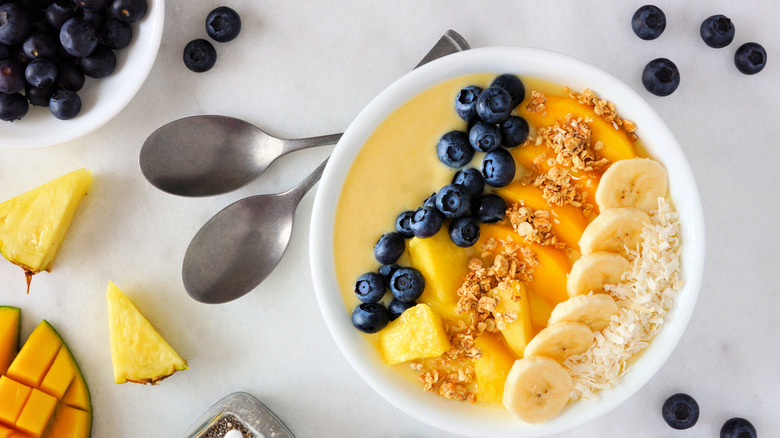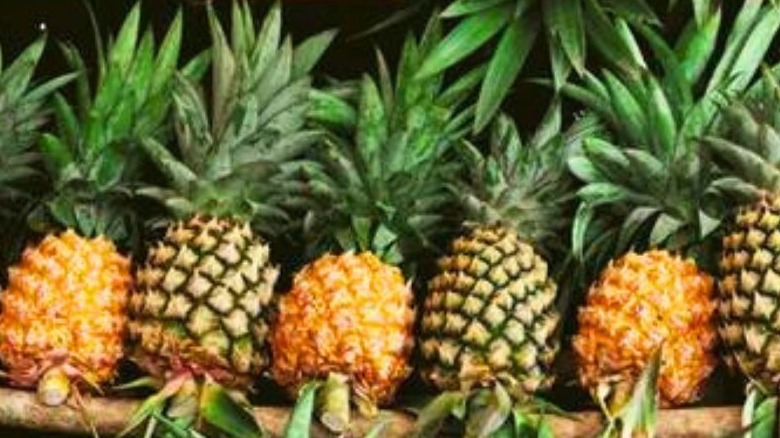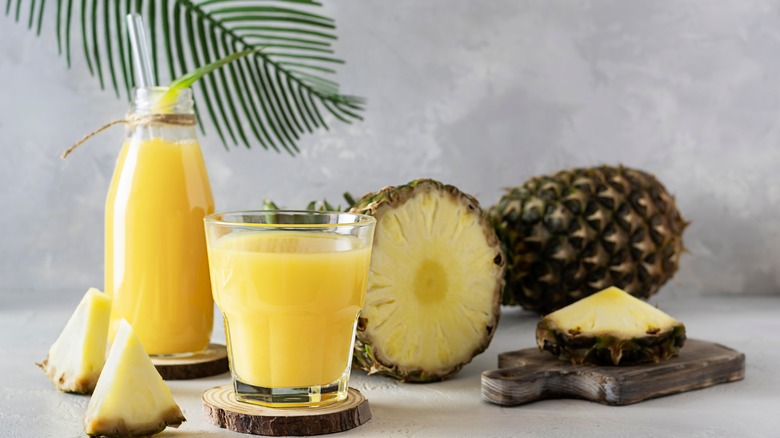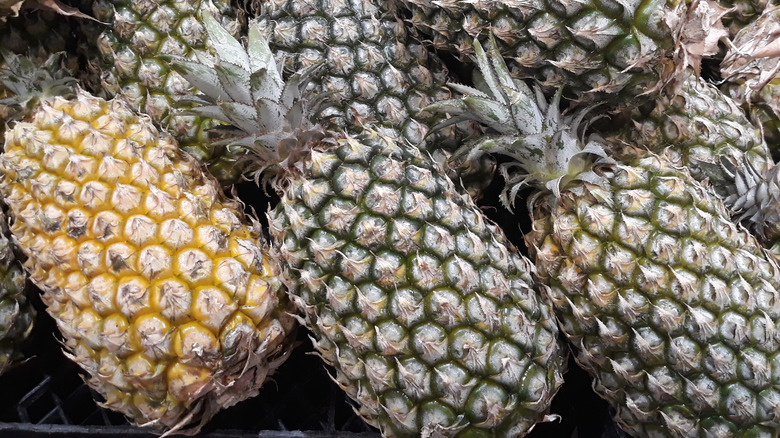12 Popular Types Of Pineapple, Explained
Pineapples are a popular ingredient in many households, whether in their fresh, spike-covered form or the more manageable canned variety. When we shop for pineapples at the grocery store, we rarely check to see the variety in the way that we would with apples, but they come in all shapes, sizes, and flavors. From the widely available Smooth Cayenne to the slightly less well-known Pernambuco or Brecheche, each distinct pineapple has its own balance of sweetness and acidity, making them suited to a variety of culinary uses.
Let's explore the tropical world of pineapples, discovering where each variety is grown and what makes it stand out from the rest. Whether you enjoy your pineapples in a refreshing smoothie, a zingy salsa, or an indulgent dessert, there's a variety out there with your name on it. So grab your sharpest knife — you'll need it for that spiky skin — and let's take a look at the most common varieties of this tropical fruit.
Smooth Cayenne
If you close your eyes and picture a pineapple, the image in your head is likely that of a Smooth Cayenne. This variety is extremely common in grocery stores across the States and in Europe, its recognizable soft spikes protecting a gorgeous yellow flesh. It originated in French Guyana, in the city of Cayenne — hence the name — but it is now grown widely across the globe, including in Hawaii, Australia, and the Philippines. It accounts for as much as 70% of the pineapples grown worldwide and is especially popular in cans.
The Smooth Cayenne variety of pineapple is substantial in size, reaching a weight of between five and six pounds, but its star quality has to be its flavor. The perfect balance of sweetness and acidity is what makes it such a popular fruit, allowing it to be used equally well in sweet and savory dishes. Its firm texture makes it ideal for slicing into rings or cubes and grilling, to add a delicious charred touch to your dishes. Whether making pineapple salsa to accompany fish or adding it to a smoothie to give it a zing, a Smooth Cayenne pineapple will take your taste buds on an exquisite journey no matter how you use it.
Supersweet
If you're ready to move on from the classic sweet-tart flavor of the Smooth Cayenne, the Supersweet variety of pineapple is a delicious option. As you may have guessed, this variety is considerably sweeter than its acidic cousins, making it a delightful option for desserts. Also known as MD2, named after Mille Dillard whose husband was involved in their cultivation, this variety of pineapple was made famous as the Del Monte Gold Extra Sweet, which became immensely popular from the 1990s. It is not as tall a fruit as the Smooth Cayenne and is a bit squarer too.
One important feature of the Supersweet pineapple is that it contains significantly more vitamin C than some other varieties — up to four times as much in some cases. Vitamin C is a crucial antioxidant that helps support immune function and is integral in keeping skin and bones healthy. Being able to boost your intake of this important vitamin in such an appetizing way means that Supersweet pineapples should be a regular in your fruit bowl or fridge.
To make the most of this mouthwatering fruit, eat it as simply as possible to appreciate its juicy flesh. Dice it up and add to a tropical fruit salad alongside mango and passion fruit, or grill and serve with a scoop of vanilla ice cream.
Red Spanish
The Caribbean often evokes images of soft, sandy beaches and tropical fruit, and the next variety of pineapple is testament to that. The Red Spanish is grown in Cuba, as well as in many countries in South America, and has a unique appearance that sets it apart from the standard pineapples in your local grocery store. The Red Spanish, as you would expect, has a deep red skin and tends to be smaller than the Smooth Cayenne. The skin is tough, and when you cut through it, you will find pale flesh with hints of color throughout. It has a slightly more acidic flavor than you may be used to, but it can still be eaten fresh alongside other sweet fruits.
This pineapple also works extremely well with savory dishes, such as in a salsa or the delicious tacos al pastor. The zing of the Red Spanish pineapple complements the savory chicken or pork beautifully, creating a dish that is bright and well-balanced. Its firm texture also means that it can be grilled without falling apart. If you're an adventurous cook, you should try and get hold of a Red Spanish pineapple instead of your usual variety and enjoy the unique twist that it can bring to your sweet and savory dishes.
Pernambuco
The Pernambuco variety of pineapple hails from Brazil, named after the Northeastern Brazilian state where it is often grown. It's a medium-sized pineapple with an oblong shape and long green leaves. It has a sweet, yellow flesh that makes it ideal for eating fresh or using in desserts and sweet treats.
If you're hankering for a traditional Brazilian drink that's not a caipirinha, you should try an aluá instead. It's a fermented pineapple drink that was classically made from scraps of the fruit, and now consists of pineapple, sugarcane, and cassava flour, which are combined and left to ferment. Due to the fermentation process, aluá is slightly alcoholic and can be a little fizzy, making it a delightful, light beverage to enjoy on a warm evening.
As well as creating delicious drinks, Pernambuco pineapple can be enjoyed in a variety of desserts. This pineapple dulce de leche crepes recipe will allow you to enjoy the naturally sweet flavor of the fruit, which also cuts through the richness of the rest of the dish. No matter how you choose to enjoy it, Pernambuco pineapple will impress you with its zingy flavor and juicy texture.
Abacaxi
The abacaxi pineapple is native to Brazil and has a similar appearance to a regular Smooth Cayenne pineapple. It looks like a slightly elongated version, with the familiar green leaves and spikes on the skin. Those in search of an incredibly sweet pineapple should perhaps look elsewhere, as the abacaxi has a more acidic flavor than many others.
Like all pineapples, the abacaxi is rich in bromelain, an enzyme that is prized for its potential as a treatment for a number of conditions, including digestive issues and osteoarthritis. For this reason, the indigenous Xakriabá people use the abacaxi plant for medicinal purposes.
The flesh of the abacaxi pineapple can be enjoyed in a variety of different ways, including drying it in the sun, which concentrates the flavor. Drying fruit is an excellent way to preserve it, as dried fruit can potentially last as long as five years, though you won't be able to resist eating it before then! If you want to try drying your own pineapple, but don't live somewhere with hot enough sun, you can do so in your kitchen instead. A dedicated dehydrator will do the trick, or you can dry it in the oven at around 175 F, for eight hours.
Honeyglow
If you're looking for a pineapple that has a sweet indulgent flavor and juicy flesh, you'll want to get your hands on a Honeyglow. This beautiful golden variety has been specifically bred to create a sweet, decadent fruit that appeals to the mass market. They are exclusive to Del Monte and are left longer on the plant to ripen, in Costa Rica, to create a flavorsome, mouth-watering fruit.
When you cut into a Honeydew pineapple, you'll be greeted with a vivid yellow flesh that will whet your appetite for the flavor that's to come. The extra-sweet taste is still balanced with a little acidity, making it suitable for many culinary ventures and snacks. In spite of its sweetness, pineapple is relatively low in calories when compared to treats made with refined sugar, making it a great option if you are trying to eat more healthily. Try sprinkling some cinnamon over the top and serving it with some natural yogurt for a dessert that's refreshing and satisfying.
Queen
Time now to look at the royalty of the pineapple world, with the Queen variety. Also called Queen Victoria, they are popular in Australia and South Africa and are available throughout the year. Despite their lofty name, Queen pineapples are actually smaller than most, only growing to around five inches tall.
The fruit has a rough outside, but inside the bright yellow flesh is tender and delicious, and the core can be eaten too. Queen pineapples prove that great things come in small packages, as the taste of this petite fruit is sweet and flavorsome. Its wonderful taste makes it a great addition to so many sweet and savory elements, from smoothies to desserts. It would make a great pineapple upside-down cake, with the sweetness adding a comforting indulgence, but with enough tartness to keep the flavors balanced.
Queen pineapples are not a great variety for canning but taste fantastic eaten fresh. Add them to fruit salads or chop them up with onions, tomatoes, and peppers for a brilliantly zingy salsa.
Sugarloaf
The name of this next pineapple will have you salivating before you even taste it, and it will not disappoint once you do. The Sugarloaf pineapple is particularly popular in Hawaii and West Africa and has a delicious interior including an edible core. It is often referred to as the white pineapple, since it has striking white flesh, inside a thin green skin that doesn't change color as it ripens.
The flesh of a Sugarloaf pineapple is not stringy or overly fibrous which, when coupled with its incredibly sweet flavor, makes it a joy to eat. If you are selecting a Sugarloaf pineapple, it's worth bearing in mind that a fruit that seems to be heavy for its size will be sweeter, and the bottom is where the sweetest flesh can be found.
You don't want to mess about too much with this delicious fruit, so prepare it simply and enjoy it as fresh as possible. Combining it with shredded veggies and a touch of fresh chili to make a zingy coleslaw is a great way to make the most of its flavor, and it will go nicely with poultry or fish. If that seems like too much effort, simply slice it and eat it naturally, enjoying the indulgent flavors and textures that it provides.
Brecheche
Prepare to meet a pineapple that is going to shatter the familiar image you are used to. The Brecheche variety is a smallish fruit that has yellow skin, but no spikes at all. This gives it a distinctive look compared to its spiky cousins, and makes it easier to prepare, though the skin is still quite tough.
These unusual pineapples are grown in Southern Venezuela and are not widely available in the rest of the world. They have a sweet taste and are a great option for smoothies and juices. For a fun twist on your usual smoothie drink, if you're fortunate enough to get a hold of some Brecheche pineapple, you can use it to make a vibrant smoothie bowl. Paired with other tropical ingredients such as mango, banana, and coconut milk, it makes a fantastic healthy breakfast or mid-afternoon snack. A sprinkling of crushed nuts or seeds will add the perfect crunch to finish it off.
Kew
Next on our list is the Kew pineapple, which is popular in India, as well as Mauritius and Australia. In the Indian district of Nagaland, in Molvom village, they have a yearly festival lasting a few days that showcases the Kew pineapple. This is a fairly small variety, with a distinctive flattened bottom, but the size of the fruit can change depending on how and where it is grown.
Kew pineapples are a delicious treat, due to their elevated sugar content and relatively low acidity. As with other varieties, the bottom of the fruit will be the sweetest, since they ripen upwards, so be sure to slice horizontally and keep the bottom section for yourself! They, of course, work brilliantly in desserts or simply eaten fresh, but they can also add a delicious tang to savory dishes. An unusual way to use them is to make a pineapple chutney, which can be served with all sorts of savory foods. By combining it with a touch of ginger and some grated apples, then simmering with various spices for a couple of hours, you will have a sweet, tangy condiment that can be served alongside grilled meat or on your next cheese platter. The natural sweetness of the Kew pineapple means you may not even need to add any sugar.
Honey Malang
In Southeast Asia, you will find the tropical treasure known as Honey Malang. This pineapple is named after the city of Malang in Indonesia, due to the abundance of the fruit that grows there. This is a smaller variety of pineapple than most, but its diminutive size doesn't mean it is short on flavor. Honey Malang pineapples, as the name suggests, are big on sweetness and low in acidity, making them a popular choice in the region.
The sweet and refreshing nature of honey Malang pineapples means that eating them fresh is by far the best option. An ideal way to enjoy the flavor and make the most of the nutrients the pineapple provides is to make fresh pineapple juice. Even if you don't have an electric juicer, you can still make delicious fresh juice in a matter of minutes. Simply add the diced Honey Malang pineapple to a blender with a splash of water or coconut water, some grated fresh ginger, and a squeeze of lemon or lime, then blend it up until smooth. If you like your juice with pulp, go ahead and pour it into a tall glass. If not, strain it through a fine sieve or milk bag to leave the pulp behind, and let the golden elixir drip through. Drink it on its own, add to a piña colada, or if you're feeling really adventurous, you could even try adding your fresh pineapple juice to your iced coffee!
Bogor
Our pineapple journey takes us now to Japan, where the Bogor pineapple can be found, particularly on Ishigaki Island, which is just off the coast of Taiwan. They are small fruits with vibrant yellow flesh and orange skin. Like all pineapples, the Bogor variety is non-climacteric, meaning that once it has been picked from the plant, it will not continue to ripen. For this reason, they are harvested at the height of their ripeness, to provide a beautifully sweet fruit with little acidity.
The unique feature of the Bogor pineapple leads to its nickname as the 'snacking pineapple' — strips of the fruit can be torn off and eaten without the need to cut it up. Since preparing pineapple can be a real pain, getting your hands on the Bogor variety could make eating pineapple a much easier task!
Other than snacking on directly, this variety of pineapple is versatile and works wonderfully in both sweet and savory dishes. If you are a fan of the wildly controversial Hawaiian pizza, why not recreate the flavors by making a pineapple ham? The sweet notes from the fruit will flavor the ham as it slowly cooks, resulting in a tangy, sweet, and salty dish that will drive your taste buds wild.
